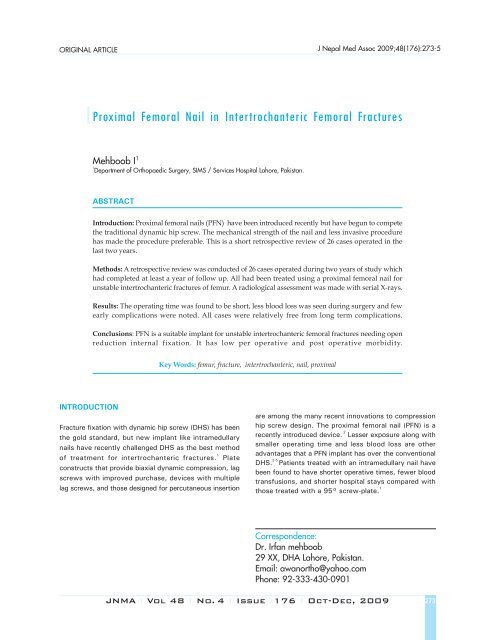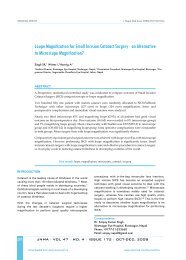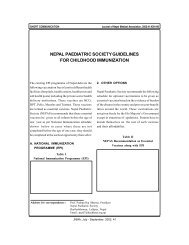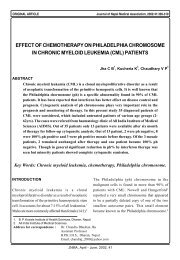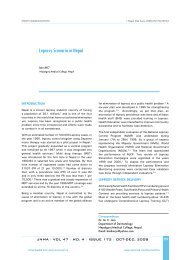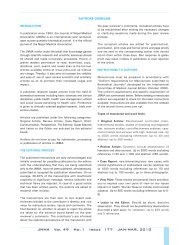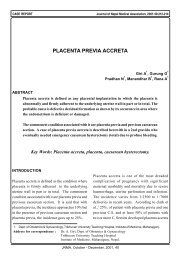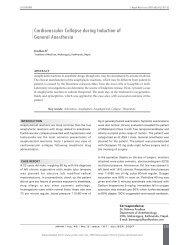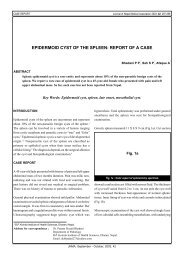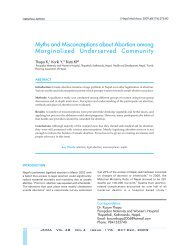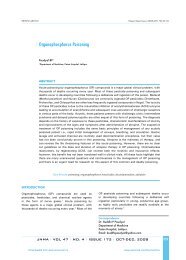Proximal Femoral Nail in Intertrochanteric Femoral Fractures
Proximal Femoral Nail in Intertrochanteric Femoral Fractures
Proximal Femoral Nail in Intertrochanteric Femoral Fractures
Create successful ePaper yourself
Turn your PDF publications into a flip-book with our unique Google optimized e-Paper software.
ORIGINAL ARTICLE J Nepal Med Assoc 2009;48(176):273-5<br />
<strong>Proximal</strong> <strong>Femoral</strong> <strong>Nail</strong> <strong>in</strong> <strong>Intertrochanteric</strong> <strong>Femoral</strong> <strong>Fractures</strong><br />
Mehboob I 1<br />
1<br />
Department of Orthopaedic Surgery, SIMS / Services Hospital Lahore, Pakistan.<br />
ABSTRACT<br />
Introduction: <strong>Proximal</strong> femoral nails (PFN) have been <strong>in</strong>troduced recently but have begun to compete<br />
the traditional dynamic hip screw. The mechanical strength of the nail and less <strong>in</strong>vasive procedure<br />
has made the procedure preferable. This is a short retrospective review of 26 cases operated <strong>in</strong> the<br />
last two years.<br />
Methods: A retrospective review was conducted of 26 cases operated dur<strong>in</strong>g two years of study which<br />
had completed at least a year of follow up. All had been treated us<strong>in</strong>g a proximal femoral nail for<br />
unstable <strong>in</strong>tertrochanteric fractures of femur. A radiological assessment was made with serial X-rays.<br />
Results: The operat<strong>in</strong>g time was found to be short, less blood loss was seen dur<strong>in</strong>g surgery and few<br />
early complications were noted. All cases were relatively free from long term complications.<br />
Conclusions: PFN is a suitable implant for unstable <strong>in</strong>tertrochanteric femoral fractures need<strong>in</strong>g open<br />
reduction <strong>in</strong>ternal fixation. It has low per operative and post operative morbidity.<br />
Key Words: femur, fracture, <strong>in</strong>tertrochanteric, nail, proximal<br />
INTRODUCTION<br />
Fracture fixation with dynamic hip screw (DHS) has been<br />
the gold standard, but new implant like <strong>in</strong>tramedullary<br />
nails have recently challenged DHS as the best method<br />
of treatment for <strong>in</strong>tertrochanteric fractures. 1<br />
Plate<br />
constructs that provide biaxial dynamic compression, lag<br />
screws with improved purchase, devices with multiple<br />
lag screws, and those designed for percutaneous <strong>in</strong>sertion<br />
are among the many recent <strong>in</strong>novations to compression<br />
hip screw design. The proximal femoral nail (PFN) is a<br />
recently <strong>in</strong>troduced device. 2 Lesser exposure along with<br />
smaller operat<strong>in</strong>g time and less blood loss are other<br />
advantages that a PFN implant has over the conventional<br />
DHS. 2-5 Patients treated with an <strong>in</strong>tramedullary nail have<br />
been found to have shorter operative times, fewer blood<br />
transfusions, and shorter hospital stays compared with<br />
those treated with a 95° screw-plate. 1<br />
Correspondence:<br />
Dr. Irfan mehboob<br />
29 XX, DHA Lahore, Pakistan.<br />
Email: awanortho@yahoo.com<br />
Phone: 92-333-430-0901<br />
JNMA I Vol 48 I No. 4 I Issue I176 I Oct-Dec, 2009 273
Mehboob et al. <strong>Proximal</strong> <strong>Femoral</strong> <strong>Nail</strong> <strong>in</strong> <strong>Intertrochanteric</strong> <strong>Femoral</strong> <strong>Fractures</strong><br />
METHODS<br />
This is a retrospective, multicentered study done at two<br />
<strong>in</strong>stitutions, Postgraduate Medical Institute, Lahore and<br />
S<strong>in</strong>dh Government Lyari General Hospital, Karachi from<br />
February, 2005 – February, 2007 for unstable fractures<br />
of proximal femur us<strong>in</strong>g the PFN. Hospital record files<br />
were used to chose the patients who were called back<br />
for review if needed. Ethical approval was taken from<br />
the ethical committee of the hospital and data was<br />
analyzed us<strong>in</strong>g the SPSS version 14. Serial X-rays if<br />
available were used to assess progress of union<br />
postoperatively. Only cases, where X-rays, at least 1<br />
year after surgery were available for review or the patient<br />
who could come back for review were <strong>in</strong>cluded (Figure<br />
1).<br />
Figure 1. Radiographs of two cases taken six weeks<br />
after surgery.<br />
Operative technique<br />
All were operated under C-arm. The patients were put<br />
<strong>in</strong> sup<strong>in</strong>e position with the affected side up. A small<br />
<strong>in</strong>cision over the greater trochanter area was made and<br />
the tip of greater trochanter was exposed and entry po<strong>in</strong>t<br />
made by us<strong>in</strong>g the femoral awl. Us<strong>in</strong>g the guide wire<br />
and the cannulated reamers the proximal femur was<br />
reamed. Hav<strong>in</strong>g seated the nail <strong>in</strong> the proximal femur the<br />
compression screw was <strong>in</strong>troduced. The distal <strong>in</strong>terlock<strong>in</strong>g<br />
screws were placed through the jig provided with the<br />
<strong>in</strong>strumentation. The f<strong>in</strong>al position was checked under<br />
the image <strong>in</strong>tensifier. The patients were given <strong>in</strong>tra venous<br />
antibiotics as prophylaxis. All were encouraged to start<br />
non weight bear<strong>in</strong>g crutch mobilization after 24 hours<br />
of surgery. Low molecular weight hepar<strong>in</strong> was used to<br />
prevent deep ve<strong>in</strong> thrombosis. All were discharged on<br />
second post operative day except when needed for other<br />
compell<strong>in</strong>g reasons.<br />
In out patient serial X-rays were taken at monthly <strong>in</strong>tervals<br />
and gradual weight bear<strong>in</strong>g was started around 6 weeks<br />
after surgery.<br />
RESULTS<br />
In all 32 patients, record was available for review but<br />
only 26 were on follow up. All patients who had been<br />
operated had returned to their work or pre-<strong>in</strong>jury status.<br />
There was radiological union accompanied by appropriate<br />
cl<strong>in</strong>ical f<strong>in</strong>d<strong>in</strong>gs. The average age of the study population<br />
was 57.24 years (range: 35-70 years). Total 10/26 were<br />
<strong>in</strong>jured <strong>in</strong> a road traffic accident and rest had domestic<br />
fall. One patient developed superficial wound <strong>in</strong>fection<br />
which settled with <strong>in</strong>tra venous antibiotics selected as<br />
per culture studies. Three patients had displacement of<br />
antirotation screws dur<strong>in</strong>g follow up at some stage<br />
(11.53%). One patient compla<strong>in</strong>ed of pa<strong>in</strong> over the<br />
trochanter area dur<strong>in</strong>g follow up. There was one case of<br />
deformation of trochanteric screw after weight bear<strong>in</strong>g.<br />
All were ambulant at the time of f<strong>in</strong>al compilation of<br />
results (Table 1).<br />
DISCUSSION<br />
The f<strong>in</strong>d<strong>in</strong>gs of Miedel <strong>in</strong>dicate that the Gamma <strong>Nail</strong><br />
showed good results <strong>in</strong> both trochanteric and<br />
subtrochanteric fractures. 6 Incidence of technical failure<br />
<strong>in</strong> patients with unstable trochanteric fracture was 6.5%<br />
(6/93) <strong>in</strong> the Standard Gamma <strong>Nail</strong> group and 5.2%<br />
(5/96) <strong>in</strong> the Medoff Slid<strong>in</strong>g Plate group. 6 Patients treated<br />
with an <strong>in</strong>tramedullary nail have had shorter operative<br />
time, fewer blood transfusions, and shorter hospital stay<br />
compared with those treated with a 95° DHS. 1 Our<br />
operation time is far less than quoted by other studies.<br />
In the study by Menezes, out of 129 patients available<br />
for follow-up failure of fixation occurred <strong>in</strong> three patients<br />
(2%), and a femoral shaft fracture occurred <strong>in</strong> one patient<br />
(0.7%). 4 No such event has been noted by us as yet<br />
but our follow up is very short, as time passes by we<br />
may note other problems. Fixation failures <strong>in</strong>cluded one<br />
cutout, one delayed fracture heal<strong>in</strong>g, and one lateral<br />
displacement of the antirotation screw. In other studies<br />
total re-operation rate was high (12%) ma<strong>in</strong>ly because<br />
of hardware removals, which occurred <strong>in</strong> 13 patients<br />
(8.6%). Stratification of results showed that hematomas<br />
and iliotibial tract irritation occurred more commonly with<br />
lesser surgical experience. 4 We have a very small group<br />
of patients hence cannot comment on problems related<br />
to learn<strong>in</strong>g curve of the procedure but we have noted<br />
our operat<strong>in</strong>g time decreased with <strong>in</strong>crease <strong>in</strong> experience.<br />
Generally, the results of treatment of unstable trochanteric<br />
fractures were comparable for the PFN and Gamma <strong>Nail</strong>.<br />
The pitfalls and complications were similar, and ma<strong>in</strong>ly<br />
surgeon or fracture-related, rather than implant-related. 2<br />
Our operat<strong>in</strong>g time was short and we did not have to<br />
transfuse blood post operatively. In other studies the<br />
<strong>in</strong>tra-operative blood loss was lower with the PFN (220<br />
ml v 287 ml, p = 0.001). 2 We did not make any direct<br />
measurements of blood lost dur<strong>in</strong>g surgery and accept<br />
this as a limitation of our f<strong>in</strong>d<strong>in</strong>gs. Post-operatively,<br />
more lateral protrusion of the hip screws of the PFN<br />
(7.6%) was documented, compared with the gamma nail<br />
(1.6%, p = 0.02) <strong>in</strong> the series published by Schipper. 2<br />
274<br />
JNMA I Vol 48 I No. 4 I Issue I176 I Oct-Dec, 2009
Mehboob et al. <strong>Proximal</strong> <strong>Femoral</strong> <strong>Nail</strong> <strong>in</strong> <strong>Intertrochanteric</strong> <strong>Femoral</strong> <strong>Fractures</strong><br />
CONCLUSIONS<br />
Though small scale and of rather short duration of follow<br />
up, our f<strong>in</strong>d<strong>in</strong>gs show that PFN has advantages over the<br />
conventional Dynamic Hip Screw. A shorter operat<strong>in</strong>g<br />
time, less blood loss, easy operative technique and lesser<br />
post operative problems po<strong>in</strong>t to the promise the implant<br />
shows. There is need for more randomised controlled<br />
trials.<br />
Most local complications were related to suboptimal<br />
reduction of the fracture and/or position<strong>in</strong>g of the implant. 2<br />
Functional outcome and consolidation were equal for<br />
both implants. Results of treatment of unstable trochanteric<br />
fractures were comparable for the PFN and Gamma <strong>Nail</strong>. 2<br />
One case of trochanteric bursitis was noted but we failed<br />
to f<strong>in</strong>d any gross lateral displacement of femoral screw<br />
<strong>in</strong> the later X-rays of this case.<br />
ACKNOWLEDGEMENTS<br />
We are thankful to those who contributed <strong>in</strong> design<strong>in</strong>g,<br />
Dr. Irfan Mehboob and implant manufactur<strong>in</strong>g, Osteomet<br />
& Co, Dr Faisal Nazeer for data research, Dr. Parvaiz<br />
Anjum for statistical analysis and those who were <strong>in</strong>volved<br />
<strong>in</strong> data collection and literature search.<br />
REFERENCES<br />
1. Sadowski C, Lübbeke A, Saudan M, Riand N, Stern R,<br />
Hoffmeyer P. Treatment of reverse oblique and transverse<br />
<strong>in</strong>tertrochanteric fractures with use of an <strong>in</strong>tramedullary nail<br />
or a 95 degrees screw-plate: a prospective, randomized study.<br />
J Bone Jo<strong>in</strong>t Surg Am. 2002 Mar;84-A(3):372-81.<br />
2. Schipper IB, Steyerberg EW, Castele<strong>in</strong> RM, van der Heijden<br />
FH, den Hoed PT, Kerver AJ et al. Treatment of unstable<br />
trochanteric fractures. Randomised comparison of the gamma<br />
nail and the proximal femoral nail. J Bone Jo<strong>in</strong>t Surg Br. 2004<br />
Jan;86(1):86-94.<br />
3. Pajar<strong>in</strong>en J, L<strong>in</strong>dahl J, Michelsson O, Savola<strong>in</strong>en V, Hirvensalo<br />
E. Pertrochanteric femoral fractures treated with a dynamic<br />
hip screw or a proximal femoral nail. A randomised study<br />
compar<strong>in</strong>g post-operative rehabilitation. J Bone Jo<strong>in</strong>t Surg Br.<br />
2005 Jan;87(1):76-81.<br />
4. Menezes DF, Gamul<strong>in</strong> A, Noesberger B. Is the proximal femoral<br />
nail a suitable implant for treatment of all rochanteric fractures?<br />
Cl<strong>in</strong> Orthop Relat Res. 2005 Oct;439:221-7.<br />
5. Mattsson P, Alberts A, Dahlberg G, Sohlman M, Hyldahl HC,<br />
Larsson S. Resorbable cement for the augmentation of <strong>in</strong>ternallyfixed<br />
unstable trochanteric fractures. A prospective, randomised<br />
multicentre study. J Bone Jo<strong>in</strong>t Surg Br. 2005 Sep;87(9):1203-9.<br />
6. Miedel R, Ponzer S, Törnkvist H, Söderqvist A, Tidermark J.<br />
The standard Gamma nail or the Medoff slid<strong>in</strong>g plate for<br />
unstable trochanteric and subtrochanteric fractures: A<br />
randomised, controlled trial. J Bone Jo<strong>in</strong>t Surg Br. 2005<br />
Jan;87(1):68-75.<br />
JNMA I Vol 48 I No. 4 I Issue I176 I Oct-Dec, 2009 275


